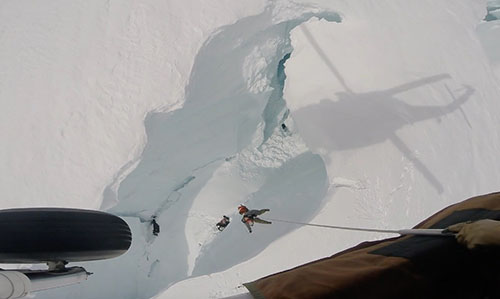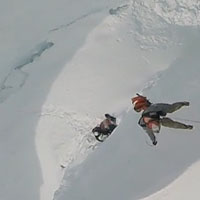— from Marcie West for Whidbey Naval Air Station —

A NAS Whidbey Island Search and Rescue crewmember is lowered down to two snowmobilers trapped on Mount Baker, May 21. It was the second rescue conducted by NAS Whidbey Island’s SAR that day, ninth of 2017.
A Search and Rescue (SAR) team of five from Naval Air Station (NAS) Whidbey Island conducted two rescues on Sunday, May 21, 2017. The first rescue was near Lake Cushman on Mount Washington at 4,500 feet and the second rescue was at 8,700 feet on the south side of Mount Baker for two snowmobilers who fell into a deep glacier crevasse.
The first rescue was requested by the Mason County Sheriff’s Department for NAS Whidbey Island SAR’s support in a joint effort to rescue a hiker who had suffered a leg injury while on Mount Washington that morning. The hiker was stuck at an elevation of about 4,500 feet. Olympic Mountain Rescue (OMR) was on scene and monitored radio frequencies to assist the helicopter as it arrived on scene.
Upon approach to the area, the SAR crew was able to sight the OMR team and the hiker on a very steep, snow-covered mountain face. The OMR team was able to pass the status of the hiker and notified the crew that they had prepared a small ledge in the snow for the hiker to be placed in a rescue litter. Once they were ready for pickup they had two crewmembers rappel down to the hiker, place him in a litter then lift him off the mountainside. After dropping the hiker at a designated landing zone, the crew returned the base.
Shortly after returning to NAS Whidbey Island, the crew got their second call of the day; two snowmobilers were apparently trapped in a crevasse within the Easton Glacier, located on the south side of Mount Baker. The snowmobilers had fallen 100 feet down a crevasse and were inaccessible by ground crew. The environmental conditions and the high altitude environment precluded other assets from being able to affect the rescue. One snowmobiler had a reported head injury and the status of the other was unknown.
Upon arrival the SAR crew located the two men in a deep crevasse at 8,600 ft., standing together on one side of glacial canyon. The large crevasse was hidden by a snow bridge and had collapsed when the snowmobile had driven over it. Fortunately, this provided a very small platform for the snowmobilers to stand. Ten feet on either side of the snowmobilers was a deep chasm. Due to the outside temperature and the body heat from the snowmobilers, the snow pack within the crevasse was beginning to melt. The crew recognized the danger the snowmobilers were in and began to affect the rescue expeditiously.
After extracting the snowmobilers in challenging conditions, the SAR crew flew the men to PeaceHealth St. Joseph Medical Center in Bellingham, Washington.
This was the ninth rescue of 2017 for NAS Whidbey Island SAR, which has also conducted four searches and 13 Medical Evacuation (MEDEVAC) missions this year.
The Navy SAR unit operates three MH-60S helicopters from NAS Whidbey Island as search and rescue/medical evacuation (SAR/MEDEVAC) platforms for the EA-18G aircraft as well as other squadrons and personnel assigned to the installation. Pursuant to the National SAR Plan of the United States, the unit may also be used for civil SAR/MEDEVAC needs to the fullest extent practicable on a non-interference basis with primary military duties according to applicable national directives, plans, guidelines and agreements; specifically, the unit may launch in response to tasking by the Air Force Rescue Coordination Center (based on a Washington State Memorandum of Understanding) for inland missions, and/or tasking by the United States Coast Guard for all other aeronautical and maritime regions, when other assets are unavailable.
**If you are reading theOrcasonian for free, thank your fellow islanders. If you would like to support theOrcasonian CLICK HERE to set your modestly-priced, voluntary subscription. Otherwise, no worries; we’re happy to share with you.**








